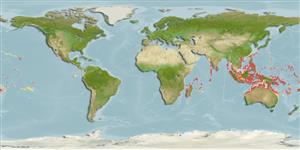>
Gobiiformes (Gobies) >
Gobiidae (Gobies) > Gobiinae
Etymology: Exyrias: Derived from Greek, xyreo = to shave (Ref. 45335).
More on author: Smith.
Environment: milieu / climate zone / depth range / distribution range
Écologie
marin récifal; profondeur 1 - 30 m (Ref. 90102). Tropical; 30°N - 30°S
Indo-West Pacific: East Africa to Samoa, north to Yaeyama Islands, south to Fiji.
Taille / Poids / Âge
Maturity: Lm ? range ? - ? cm
Max length : 15.0 cm SL mâle / non sexé; (Ref. 48637)
Épines dorsales (Total) : 7; Rayons mous dorsaux (Total) : 10 - 12; Épines anales: 1; Rayons mous anaux: 9 - 10; Vertèbres: 26. Dorsal half of body brown, ventral half yellow, with 7-8 dark brown bars. Small silvery white spots on cheeks and opercula. Predorsal scales 8 or 9. Usually, spines on 1st dorsal fin elongated into filaments with the 3rd and 4th typically longest; spine of 2nd dorsal fin with red and white alternating bands, spots on rays and membrane. Cycloid scales only on nape and isthmus. Cheeks and opercula fully scaled. Teeth small and tightly packed in jaws. Depth of body about 3.6-3.9 in SL (Ref. 90102).
A territorial species that inhabits lagoon and seaward reefs (Ref. 9710, 48637). Found over silty bottoms near or under overhanging corals. Feeds by sifting the sediment through its gill rakers (Ref. 1602).
Life cycle and mating behavior
Maturité | Reproduction | Frai | Œufs | Fécondité | Larves
Murdy, E.O., 1985. A review of the gobiid fish genera Exyrias and Macrodontogobius, with description of a new species of Exyrias. Indo-Pac. Fish. (10):14 p. (Ref. 403)
Statut dans la liste rouge de l'IUCN (Ref. 130435: Version 2024-1)
Menace pour l'homme
Harmless
Utilisations par l'homme
Pêcheries: commercial; Aquarium: Commercial
Outils
Articles particuliers
Télécharger en XML
Sources Internet
Estimates based on models
Preferred temperature (Ref.
123201): 26.2 - 29.3, mean 28.6 °C (based on 2723 cells).
Phylogenetic diversity index (Ref.
82804): PD
50 = 0.5312 [Uniqueness, from 0.5 = low to 2.0 = high].
Bayesian length-weight: a=0.00724 (0.00397 - 0.01320), b=3.06 (2.90 - 3.22), in cm total length, based on LWR estimates for this species & (Sub)family-body (Ref.
93245).
Niveau trophique (Ref.
69278): 2.8 ±0.30 se; based on food items.
Résilience (Ref.
120179): Milieu, temps minimum de doublement de population : 1,4 à 4,4 années (Preliminary K or Fecundity.).
Fishing Vulnerability (Ref.
59153): Low vulnerability (10 of 100).
Nutrients (Ref.
124155): Calcium = 88.7 [47.7, 165.5] mg/100g; Iron = 0.717 [0.373, 1.276] mg/100g; Protein = 18.3 [16.3, 20.0] %; Omega3 = 0.134 [0.064, 0.222] g/100g; Selenium = 23.6 [13.5, 44.1] μg/100g; VitaminA = 117 [31, 370] μg/100g; Zinc = 1.84 [1.26, 2.67] mg/100g (wet weight);
